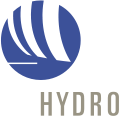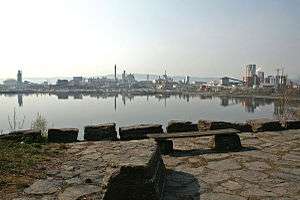Norsk Hydro
 | |
| Allmennaksjeselskap | |
| Traded as |
OSE: NHY OTCQX: NHYDY |
| Industry | Metals |
| Founded | 1905 |
| Headquarters | Oslo, Norway |
Key people | Svein Richard Brandtzæg (President and CEO), Dag Mejdell (Chairman) |
| Products | Aluminium and related products; hydropower and solar power technologies |
| Revenue | NOK 75.75 billion (2010)[1] |
| NOK 3.184 billion (2010)[1] | |
| NOK 1.888 billion (2010)[1] | |
| Total assets | NOK 88.79 billion (end 2010)[1] |
| Total equity | NOK 57.25 billion (end 2010)[1] |
Number of employees | 23,000 (end 2010)[1] |
| Website | www.hydro.com |

Norsk Hydro ASA (often referred to as just Hydro) is a Norwegian aluminium and renewable energy company, headquartered in Oslo. Hydro is one of the largest aluminium companies worldwide. It has operations in some 50 countries around the world and is active on all continents. The Norwegian state owns 43.8% of the company through the Ministry of Trade and Industry. A further 6.5% is owned by Folketrygdfond, which administers the Government Pension Fund of Norway. Norsk Hydro employs approximately 12,500 people.[2] Svein Richard Brandtzæg has been the CEO since 2009.
The company had a significant presence in the oil and gas industry until October 2007, when these operations were merged with rival Statoil to form StatoilHydro (in 2009 changed back to Statoil).
History
The first steps with fertilizer
Financed by the Swedish Wallenberg family and French banks, the company was founded on December 2, 1905 as Norsk hydro-elektrisk Kvælstofaktieselskab (lit. Norwegian hydro-electric nitrogen limited) by Sam Eyde, exploiting a novel technology for producing artificial fertilizers by fixing nitrogen from air. The technology had been developed by the Norwegian scientist Kristian Birkeland. The method is still known as the Birkeland–Eyde process. The process required large amounts of electric energy, and for this, a power plant was built at the Svelgfossen waterfall near Notodden. Later also Rjukan Falls was developed and its power harnessed, in the process establishing the city of Rjukan, establishing the plant Norsk Hydro Rjukan.
Hydro's first factory was built at Notodden (opened in 1907) followed up with another at Rjukan, Tinn (opened in 1911). Then in 1912 production is established at Glomfjord in Nordland. In 1930 Norsk Hydro opened a plant at Herøya outside Porsgrunn. To begin with it was to function as a shipping port for the fertilizer as well as a point to import limestone. From 1936 Hydro also started producing fertilizer at Herøya. There was also opened a railway, Rjukanbanen, connecting Rjukan with Hærøy. The railway opened in 1909 and consisted of a railway ferry across Lake Tinn, railway again with Tinnosbanen and a barge ride from Borgestad to Herøya with barge on the Telemark Canal. The canal was superseded by the railway line Bratsbergbanen in 1916.
By the 1920s, Norsk Hydro's electric arc-based technology for manufacturing artificial fertilizer was no longer able to compete with the newly developed Haber-Bosch process, and in 1927 the company formed a partnership with the German company IG Farben in order to gain access to this process. By 1945, IG Farben had become a majority shareholder in Norsk Hydro. The plant at Herøya was a direct result of no longer being dependent on immediate proximity to the power sources. This provided the advantage of being able to have the plants and the shipping port in the same location, as was the case with the Herøya plant.
Heavy water production at Rjukan

The Rjukan plant was the only location in Europe which produced heavy water, a component the Allied powers in World War II feared would be used as part of the German atomic bomb project, and consequently was the target of several commando and air raids and a sabotage raid which eventually resulted in the plant's destruction and later reconstruction.
The first metal
The first steps towards light metal production came in 1940 when Hydro started construction of a magnesium carbonate plant at Herøya, but the German invasion of Norway stopped the plans.
In 1941 the Oslo Consortium (Norwegian: Oslo-konsortiet) invested money equivalent to year 2014 Norwegian kroner 172 million.[3] (The consortium included Thomas Fearnley, Orkla, Fred Olsen, Storebrand, Jens P. Heyerdahl, Klaveness & Co, Christopher Kahrs Kielland.[3]) Collaboration with the Nazi-German regime, did not result in any company employees being convicted (for collaboration) after the war.[3]
During the Second World War Norsk Hydro collaborated with IG Farben and Nordische Aluminium Aktiengesellschaft (Nordag) in building new aluminium and magnesium plants in support of the German war effort. The construction was however ended on July 24, 1943 when an allied bombardment completely destroyed the facilities, killing 55 construction workers. As Germany's defeat became more likely, Norsk Hydro started to tone down its collaborative relations with the occupier.
In 1946 the Årdal aluminium plant was opened, operated by the state owned company Årdal og Sunndal Verk. In a merger Hydro acquired this company in 1986, in essence establishing the light metal division Hydro Aluminium.
Since 1919 there had first been zinc, then aluminium production at Glomfjord in Northern Norway. Hydro bought the power plant in 1947 and started ammonia production there instead. In the 1950s Hydro opened a new magnesium plant in Herøya and in 1963 Hydro started in cooperation with Harvey Aluminum a plant at Karmøy to produce aluminium. The plant, called Alnor, was purchased in whole by Hydro in 1973.
In 2000, Hydro acquired Wells Aluminum, a network of aluminium extrusion plants in the United States. Two years later, the company acquired the leading German aluminium producer Vereinigte Aluminium Werke from the German utility company E.ON and the French building systems company Technal.
Hydro became a truly integrated aluminium company in 2011, when it acquired the aluminium assets owned by Vale in Brazil. This made Hydro a significant player in bauxite mining and alumina refining.
Into the petroleum age
In 1965 Hydro joined Elf Aquitaine and six other French companies to form Petronord to perform search for oil and gas in the North Sea. Hydro soon became a large company in the North Sea petroleum industry, and also became operator of a number of fields, the first being Oseberg.
In 1969 Hydro started its first international operations, with a 25% stake in a fertilizer plant in Qatar.
Hydro acquired in the late 1980s the Mobil service stations in Norway, Sweden and Denmark, changing their name to Hydro. In 1995 Hydro merged its gas stations in Norway and Denmark with the Texaco, creating the joint venture HydroTexaco. The service station chain was sold in 2006 to Reitangruppen. In 1999 Hydro acquired Norway's third largest petroleum company Saga Petroleum, which had major upstream operations primarily in Norway and the United Kingdom. The British operations were later sold.
Hydro's fertilizer business was spun off as a separately stock-listed company under the name of Yara International on March 26, 2004. Hydro distributed all its Yara shares to Hydro's shareholders and presently has no ownership in Yara.
In December 2006 Norsk Hydro revealed a proposal to merge their oil business with compatriate oil and gas company Statoil.[4] Under the rules of the EEA the proposal was approved by the European Union on May 3, 2007[5] and by the Norwegian Parliament on June 8, 2007.[6] The merger was completed by 1 October 2007. Hydro’s shareholders took 32.7% of the new company—StatoilHydro—shares.[5]
Operations
Aluminium
.jpg)
Hydro is one of the largest aluminium companies worldwide. In Norway Hydro has plants in Rjukan, Raufoss, Vennesla, Karmøy, Høyanger, Årdal, Husnes, Sunndalsøra, and Holmestrand. The corporation also has many plants abroad, including in Germany and Brazil.
In 2010, Hydro and Qatar Petroleum inaugurated their 50-50 joint venture Qatalum, located in Qatar. It was the largest aluminium plant ever launched in one step. Its annual capacity in September 2011 was 585,000 metric tons of primary aluminium,[7] all to be shipped as value added aluminium casthouse products. A 1350 MW natural gas power plant was also built to ensure a stable supply of electricity.[8]
In 2010, Hydro acquired the Brazilian bauxite, alumina and aluminium production assets of Vale, an international mining and metals company.
In September 2013, Hydro combined its aluminium extrusion operations with that of Sapa, which is now a 50/50 joint venture between Hydro and the Norwegian company Orkla. Sapa Group, headquartered in Oslo, has 23,000 employees worldwide.
Energy
Hydro is a major producer of hydroelectric power in Norway.
To secure electricity for its aluminium production Hydro has signed a power purchase agreement with the Fosen Vind wind farm, which is scheduled to be fully operational in 2020. Under this agreement Fosen Vind will deliver around 0.6 TWh in 2020, around 1.0 TWh annually from 2021-2035 and 0.7 TWh annually from 2036-2039, for a total of about 18 TWh over a 20-year period.[9]
Hydro Agri
Though Hydro started off as a fertilizer producer and agricultural products was for a long time one of the companies major ventures, the agricultural division was in 2004 demerged into the independent company Yara International, listed on the Oslo Stock Exchange.
Chief Executive Officers
- 1905–1917 Sam Eyde
- 1918–1926 Harald Bjerke
- 1926–1941 Axel Aubert
- 1941–1956 Bjarne Eriksen
- 1956–1967 Rolf Østbye
- 1967–1977 Johan B. Holte
- 1977–1984 Odd Narud
- 1984–1991 Torvild Aakvaag
- 1991–2001 Egil Myklebust
- 2001–2009 Eivind Reiten
- 2009– Svein Richard Brandtzæg
References
- 1 2 3 4 5 6 "Annual Report 2010" (PDF). Norsk Hydro. Retrieved 17 April 2011.
- ↑ http://www.hydro.com/en/Investor-relations/Reporting/Annual-report-2013/Hydro-in-figures-2013/
- 1 2 3 Nazi-Tysklands venner - Mange prominente herrer tjente store penger på tysk samarbeid under krigen. Etterpå gikk de fri, mens «tyskertøsene» ble jaget. (Nazi Germany's friends - Many prominent gentlemen earned great sums through cooperation with Germans during the war. Afterwards they walked free, while the «tyskertøsene» became hunted)
- ↑ Hydro's oil and gas activities to merge with Statoil, Norsk Hydro, published 2006-12-18, accessed 2007-06-20
- 1 2 EU regulators approve Statoil, Norsk Hydro merger, EU Business, published 2007-05-03, accessed 2007-06-20
- ↑ Norwegian Parliament Okays Statoil-Hydro Merger, Ocean-Resources, published 2007-06-11, accessed 2007-06-20
- ↑ "Qatalum at full production". Qatalum. 25 September 2011. Retrieved 18 September 2015.
- ↑ "Qatar Aluminium (Qatalum)". Qatar Petroleum. Retrieved 18 September 2015.
- ↑ "Norsk Hydro: Hydro signs new long-term power contract for Norwegian aluminium portfolio". Norsk Hydro. 2016-02-23. Retrieved 2016-08-21.
External links
Coordinates: 59°54′50.97″N 10°39′2.42″E / 59.9141583°N 10.6506722°E